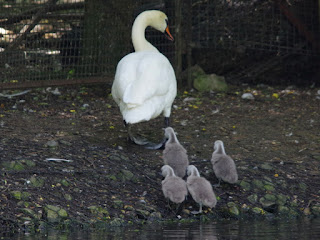I had a trip round the island, courtesy of Bluebird Boats. It is absolutely lined with Coot nests and chicks of all sizes ...
... and there is also a brood of Moorhens. The chicks can climb through the mesh of the wire baskets of plants surrounding the island.
The wire mesh barriers of the small boathouses, intended to keep birds out, are no obstacle to adult Coots ...
... which simply dive underneath.
There must have been at least four Mute Swan nests on the island, since there are three families on the Serpentine. They are very hard to see from the land or the water. A fourth nest on the corner of the island, which was occupied for some time, seems to have been a failure, abandoned with infertile eggs in it.
The island has a circular wire fence on it, and one pair of swans always nests just inside the gate. When the cygnets hatch, the family spends a lot of time sitting in the gateway, making it hard for other birds to pass, both the other swans and the geese which nest inside the enclosure. Here the mother of the family brings her cygnets ashore in front of the gate.
The heavy growth of weed on the Long Water, brought on by the recent warm weather, provides a feast for Mute Swans. But only the dominant family can enjoy it, as they have chased all the other swans away on to the Serpentine.
The newest Egyptian Goose family on the Round Pond still has seven goslings, in spite of attacks by the dominant Egyptian family. There are not many gulls on the pond at the moment, another bonus.
The teenage Grey Heron which has been occupying the abandoned heron nest on the island flew up to a very thin treetop and had to flap to keep its balance.
Even when the weather is dry there is enough water left in the place on the Vista where the drain is broken for a Wood Pigeon to enjoy a cooling bath on a hot day. They are not fussy about the water being muddy,
The female Little Owl near the leaf yard was in the tree on the uphill side of the nest tree.
A young Robin in the leaf yard waited on a twig for its parents to bring food.
Some Long-Tailed Tits flew through the nearby trees.
A male Black-Tailed Skimmer dragonfly basked on a warm granite kerbstone. Their blue-grey colour is a loose powdery coating -- this is called pruination. Heavy rain can wash it off, leaving them looking much like the yellow and black females.












I learned a new word today! Pruination. I thought it may be related to Latin pruina ('rime') and lo and behold, it is. In Spanish "pruina" means the waxy coating of some plants; it stems from the same Latin root.
ReplyDeleteThe picture of the emerging Coot is all kinds of fabulous! Well done Virginia!
Where are the Gulls from the Round Pond off to?
It does look rather like rime. And you can see on this slightly tatty dragonfly that it comes off as easily.
DeleteThere are never as many big gulls on the Round Pond as on the main lake. Many gulls will be at the breeding colony in Paddington north of the park, or breeding elsewhere. A fair number remain on the lake.